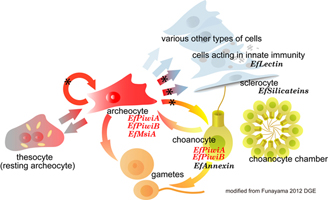RESEARCH
Sponges (poriferans) are the evolutionarily oldest extant metazoans, and thus they can give us clues about the origins of cellular and molecular mechanisms that developed during the evolution of multi-cellular animals.
We are focusing on two projects;
I) The Molecular and Cellular Bases of the Stem Cell System in Demosponges
We want like to clarify the cellular and molecular bases of the stem cells in demosponges, and would like to compare them with those in other animals to ask what is the fundamental molecular base of the stem cell and how it evolved.
We want like to clarify the cellular and molecular bases of the stem cells in demosponges, and would like to compare them with those in other animals to ask what is the fundamental molecular base of the stem cell and how it evolved.
Recently we are focusing on the molecular bases of these two types of cells both by analyzing their mRNA expression profiles using in situ hybridization and deep-sequencing.
II) How Sponge Cells Build up the Hierarchical Spiculous Skeleton
The beautiful hierarchical organization of the spiculous skeleton of glass sponges, including that of Euplecetella sp., has attracted scientific interest for more than a century, although, the mechanisms by which sponge cells construct the spiculous skeleton still remains largely unexplored. Spiculous skeleton construction is one of the most elegantly engineered self-organizations in organisms. Recently we are exploring on how sponge cells build up their spiculous skeleton step by step.


